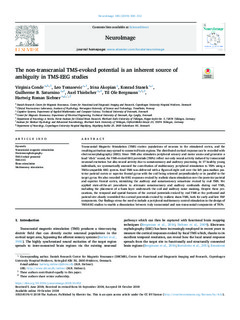| dc.contributor.author | Conde, Virginia | |
| dc.contributor.author | Tomasevic, Leo | |
| dc.contributor.author | Akopian, Irina | |
| dc.contributor.author | Stanek, Konrad | |
| dc.contributor.author | Saturnino, Ghilherme | |
| dc.contributor.author | Thielscher, Axel | |
| dc.contributor.author | Bergmann, Til Ole | |
| dc.contributor.author | Siebner, Hartwig Roman | |
| dc.date.accessioned | 2019-02-14T09:07:32Z | |
| dc.date.available | 2019-02-14T09:07:32Z | |
| dc.date.created | 2018-11-15T14:25:36Z | |
| dc.date.issued | 2018 | |
| dc.identifier.citation | NeuroImage. 2018, 185 300-312. | nb_NO |
| dc.identifier.issn | 1053-8119 | |
| dc.identifier.uri | http://hdl.handle.net/11250/2585377 | |
| dc.description.abstract | Transcranial Magnetic Stimulation (TMS) excites populations of neurons in the stimulated cortex, and the resulting activation may spread to connected brain regions. The distributed cortical response can be recorded with electroencephalography (EEG). Since TMS also stimulates peripheral sensory and motor axons and generates a loud "click" sound, the TMS-evoked EEG potentials (TEPs) reflect not only neural activity induced by transcranial neuronal excitation but also neural activity due to somatosensory and auditory processing. In 17 healthy young individuals, we systematically assessed the contribution of multisensory peripheral stimulation to TEPs using a TMS-compatible EEG system. Real TMS was delivered with a figure-of-eight coil over the left para-median posterior parietal cortex or superior frontal gyrus with the coil being oriented perpendicularly or in parallel to the target gyrus. We also recorded the EEG responses evoked by realistic sham stimulation over the posterior parietal and superior frontal cortex, mimicking the auditory and somatosensory sensations evoked by real TMS. We applied state-of-the-art procedures to attenuate somatosensory and auditory confounds during real TMS, including the placement of a foam layer underneath the coil and auditory noise masking. Despite these precautions, the temporal and spatial features of the cortical potentials evoked by real TMS at the prefrontal and parietal site closely resembled the cortical potentials evoked by realistic sham TMS, both for early and late TEP components. Our findings stress the need to include a peripheral multisensory control stimulation in the design of TMS-EEG studies to enable a dissociation between truly transcranial and non-transcranial components of TEPs. | nb_NO |
| dc.language.iso | eng | nb_NO |
| dc.publisher | Elsevier | nb_NO |
| dc.relation.uri | https://www.sciencedirect.com/science/article/pii/S105381191832024X | |
| dc.rights | Navngivelse 4.0 Internasjonal | * |
| dc.rights.uri | http://creativecommons.org/licenses/by/4.0/deed.no | * |
| dc.title | The non-transcranial TMS-evoked potential is an inherent source of ambiguity in TMS-EEG studies | nb_NO |
| dc.title.alternative | The non-transcranial TMS-evoked potential is an inherent source of ambiguity in TMS-EEG studies | nb_NO |
| dc.type | Journal article | nb_NO |
| dc.type | Peer reviewed | nb_NO |
| dc.description.version | publishedVersion | nb_NO |
| dc.source.pagenumber | 300-312 | nb_NO |
| dc.source.volume | 185 | nb_NO |
| dc.source.journal | NeuroImage | nb_NO |
| dc.identifier.doi | 10.1016/j.neuroimage.2018.10.052 | |
| dc.identifier.cristin | 1631032 | |
| dc.description.localcode | © 2018 The Authors. Published by Elsevier Inc. This is an open access article under the CC BY license (http://creativecommons.org/licenses/by/4.0/) | nb_NO |
| cristin.unitcode | 194,67,40,0 | |
| cristin.unitname | Institutt for psykologi | |
| cristin.ispublished | true | |
| cristin.fulltext | original | |
| cristin.fulltext | postprint | |
| cristin.qualitycode | 2 | |

